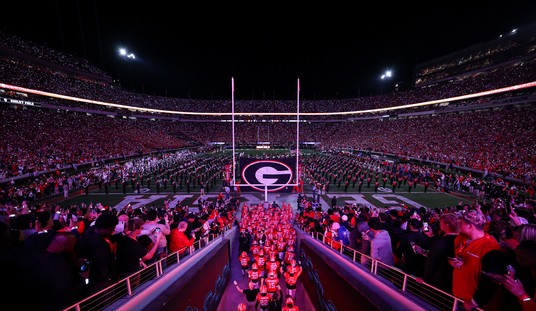Cyprus is not the most happening travel spot in the Mediterranean unless you want to get drunk and party with loutish middle class Brits. It’s quiet, culturally blank, and underdeveloped. Its archeological sites are profoundly underwhelming. Most places on the south side of the island feel like North Dakota with Greeks. With the exception of the genuinely charming port town of Kyrenia (aka Girne), the north side of the island feels like North Dakota with Turks.
But the capital of Nicosia is interesting because it is troubled. It is, I believe, the last divided capital in the world. The partition across the island is called the Attila Line. But in Nicosia it’s called the Green Line. It slashes right through the heart of the old city. Turkish Cypriots built a modern city to the north of it. Greek Cypriots built a modern city to the south. It’s not a fun place to visit, but if you go there you will find some drama — a refreshing change for the kind of person who gets bored by the dreary and stultifying resort towns on the coast.
Cyprus is a member of the European Union. But the E.U. only “controls” the southern half. The Turkish military prevents the internationally recognized government (which is supposed to be Cypriot, not “Greek Cypriot”) from governing the whole thing. It has been this way since the invasion – which was backed by Nixon and Kissinger – in 1974.
I don’t want to leave you with the impression that only the Turks are to blame. They aren’t. Cyprus was seized in a coup sponsored by the military junta that ruled Greece in the late sixties and early seventies. The junta aimed to annex Cyprus to Greece. Prior to Cyprus’s independence, EOKA fighters waged war against the occupying British soldiers and also against Greek Cypriot and Turkish Cypriot civilians opposed to enosis, or union, with Greece. Before and during the reign of the junta, EOKA was resurrected as EOKA-B and continued its war (this time in a nastier form) against both Greek Cypriot and Turkish Cypriot civilians.
The junta collapsed in Greece, which triggered the collapse of the Cyprus junta later that day. But the Turks invaded anyway (a bit late, one could say) ostensibly to protect Turkish Cypriot civilians from oppression and terror. An ethnic population exchange followed Turkey’s imposition of apartheid.
I am going to write about this at more length and in detail. This hotspot is completely ignored by almost everyone in the West, even though two NATO members use Cyprus against each other in their own private cold war. But first I want to show you what it looks like. Most of the photos shown below were taken illegally.

This, right here, is what one border of the E.U. looks like. I took this shot from the “Greek” side. The enemy, if that is the word, on the other side is a member of NATO and hopes to join the E.U.

The Greek Cypriot government set up a propaganda lookout point for tourists. I would have taken a photo from the platform, but as you can see a soldier stands guard. From the platform you can look out onto a long street in the buffer zone ruined by war and 31 years of neglect. Abandoned homes and businesses are inside the zone. You can still read the old store signs.


Right next to the lookout point are photos of Greek Cypriot civilians after the invasion waving pictures of missing loved ones.

But the Greek Cypriots lose credibility when they glorify an organization that committed terrorism and wanted to annex Cyprus to Greece rather than let it remain independent. Turkey isn’t the only country that needs to make some adjustments. EOKA was also a national liberation movement, to be sure. They were more than just terrorists. But the Turkish Cypriots understandably don’t trust them nor the intentions of those who uphold them.

I found an abandoned house near the Green Line on the Greek side. No lights were on (obviously) and I could not see a thing inside. I held my camera up to the window, turned on the flash, and snapped this picture.

One chair is all that remains of this house destroyed, most likely, during the invasion.

Here is a temporarily unstaffed military post on the Greek side of the line.

An abandoned house on the Green Line, Greek side.

Oil drums filled with concrete mark out one part of the Green Line next to a parking lot at the entrance to the old city.

Sandbags in windows on the Green Line.

The only “Turks” the “Greeks” are allowed to see walk the line at this point. I took this photo from the Greek side.

I snapped this photo across the street from the Greek Embassy right next to the buffer zone. The Greek Cypriots love to wave the bloody shirt. They have plenty of genuine grievances, to be sure. But I saw no anti-Greek propaganda on the Turkish side. Note the Greek flag. Greek Cyprus is not part of Greece.

The Turkish Republic of Northern Cyprus may not wave the bloody shirt. But it does love to fly its flag, along with the Turkish flag, above Greek neighborhoods in Nicosia.

Here’s the ultimate example of the Turkish side waving its flag in the face of the Greeks. They painted it on a mountain side where it’s clearly visible from Nicosia and during the long drive into the city.

A pedestrian crossing point is open next to the old Ledra Palace Hotel in the U.N. controlled buffer zone.

A U.N. watch tower in the buffer zone.

Bullet holes in a dormitory for U.N. soldiers inside the buffer zone.

A taxi stand in the shattered buffer zone for pedestrians coming in from the Turkish Republic of Northern Cyprus.

The Green Line on the Turkish side is not as ugly or “photogenic” as the Green Line on the Greek side. This is what it tends to look like. (I get the sense that the Greek side makes the line ugly on purpose to punch up its propaganda value.)

A young Turkish Cypriot girl watches me take a picture of the Green Line from the Turkish side.









Join the conversation as a VIP Member